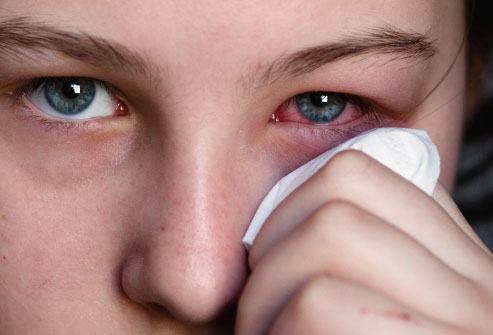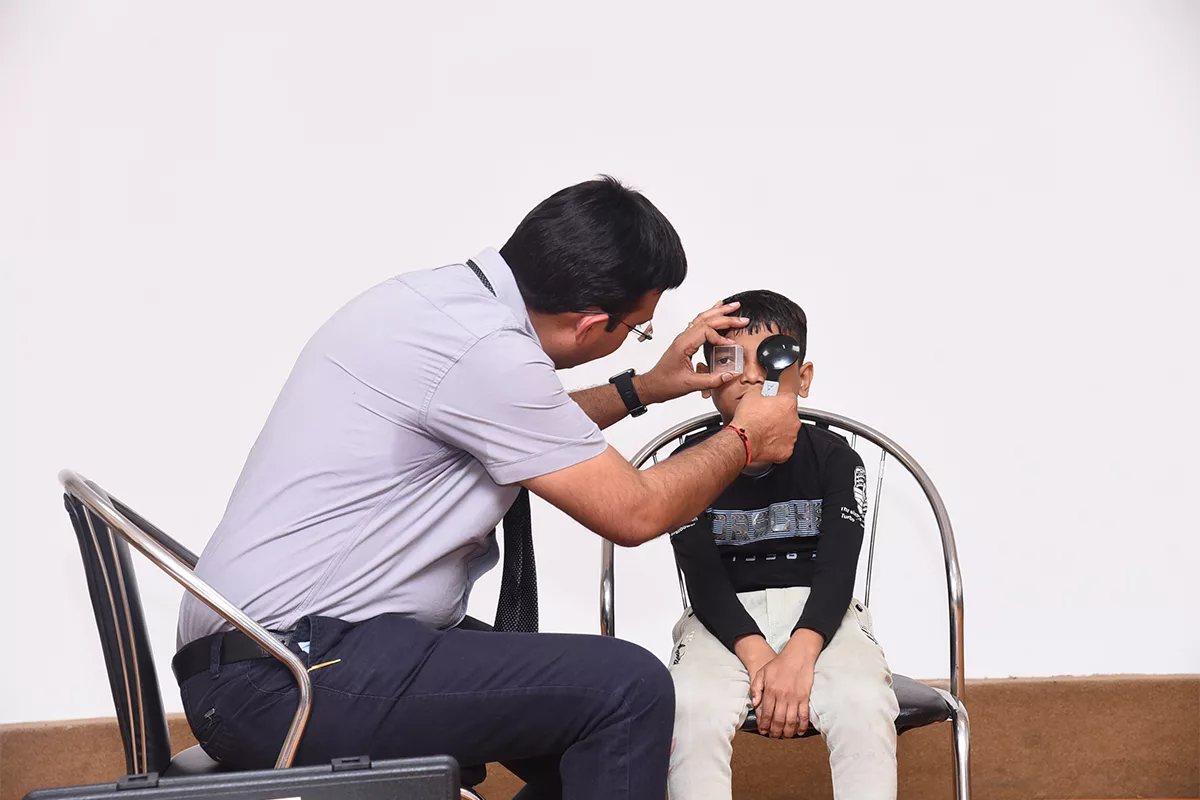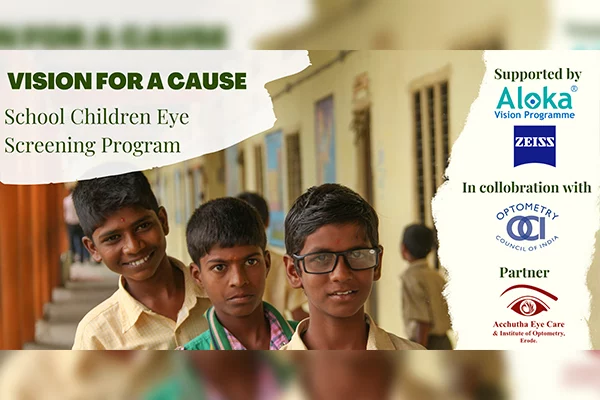Conjunctivitis, commonly known as pink eye, is an infection of the inner lining of the eye, causing watering, irritation, redness and discharge from eyes

Exposing your eyes to an unclean and closed environment can trigger the onset of several types of eye diseases. Conjunctivitis or pink eye is one such condition. Anyone can get pink eye, especially during the summer and rainy seasons. From bacteria to viruses and even certain allergens like pollen and dust, there are several factors that can trigger this eye condition.
Conjunctivitis is usually short lived and resolves by itself. It may affect one or both eyes; often it starts with one eye and then proceeds to involve both eyes. Pink eye usually occurs in epidemics affecting several people in the community at once. Crowded or closed communities such as schools, day care facilities, mass transit systems, and closed gated communities like military barracks, prisons, etc., are particularly vulnerable. Isolated cases have also been reported. Basic knowledge of the nature of this condition, its clinical course and measures for maintaining personal hygiene will help in prevention and care.
Epidemiology
The World Health Organization (WHO) estimates that nearly 10 million people are affected with blindness due to infectious diseases. Conjunctivitis, due to various causes, is a common cause of ocular morbidity in India, South East Asia and Sub Saharan Africa. Conjunctivitis can equally affect both genders of all ages. The prevalence varies with the age of the person, seasons of the year as well as the underlying cause. For instance, an episode of viral conjunctivitis is more common in the summer months in people of all ages. On the other hand, in children and adolescents, an allergic variant of conjunctivitis with irritation, itching, redness and discharge from eyes with frequent eye rubbing is common in spring or summer.
Types Of Conjunctivitis
The causes of conjunctivitis can be broadly divided into infectious and non-infectious. The infectious causes are most frequently due to viruses or bacteria. The non-infectious causes may be several, such as allergy and exposure to chemicals. The most frequent causes are usually infectious and allergic conjunctivitis.
The symptoms of allergic conjunctivitis are itching, burning sensation, redness, watering, stringy discharge, puffy eye lids and sensitivity to light. If any of these symptoms are prominent, it is important to consult an eye doctor to rule out possibilities of other diseases such as glaucoma, uveitis and keratitis, to mention a few.

Symptoms
Irritation in the eye is a common symptom that a person suffering from conjunctivitis is most likely to experience. Conjunctivitis is often associated with redness, and irritation of one or both eyes. There may be a slight swelling on the eyes with watering. Often there is copious discharge and sticking of eyelashes, which is more while getting up in the morning. A sandy and gritty feeling of the eyes is quite common. Associated cold, fever, sore throat and runny nose are also common. Often several members of the community are affected simultaneously because a lot of times people tend to ignore the initial symptoms that indicate the on-set of the disease.
Children and adolescents may be affected with allergic conjunctivitis in spring or summer. In this form of the disease, the patient will experience a slight discharge, which is ropey or stringy. Frequent eye rubbing, redness and watering of both eyes are also noticed. Often there may be associated cold, fever, cough and even asthmatic attacks. It is considered that the manifestation of the eye condition is a part of the generalised allergic reaction of the body to external allergens like dust, pollen, animal dander, etc. However, if such symptoms are noticed, one must not delay the visit to an ophthalmologist.
Diagnosis
As several conditions may cause redness of eyes, it requires examination by a health care professional. It is important to know for how long the eye problem has existed, if anyone else is also afflicted in the same family or social circle, what is the type of discharge from the eyes and if it is watery, mucinous or copious and thick. It is important to look for more serious symptoms like pain in the eyes, blurred vision, sensitivity to light and any associated injury to the eyes. All of these require a prompt referral to a medical practitioner in order to avoid the development of complications.

Treatment
Treatment of conjunctivitis is as per the cause. One must avoid self-medication and prefer treatment as per the advice of the doctor. Most cases of conjunctivitis tend to clear up in one to two weeks even without treatment. A large part of the treatment for conjunctivitis is aimed at providing symptomatic relief and decreasing the duration and severity of the condition. Patients who suffer from watering, mild pain, redness, and grittiness of eyes of a short duration may be having viral conjunctivitis. Maintaining good hygiene by frequent hand washing and avoiding sharing of personal items such as handkerchiefs is advisable. Keeping a cold compress over the eyes provides symptomatic relief. Lubricating eye drops may help relieve irritation. If symptoms persist or worsen then a prompt referral to a health care professional is needed. Frequent sticking of the eyelashes with copious amount of mucous discharge from eyes, redness and mild discomfort is suggestive of bacterial conjunctivitis. Maintaining local hygiene with instillation of an antibiotic eye drop is helpful. It is not uncommon for infection to spread to the other eye, hence one may use eye drops in both eyes. This condition is often self-limiting and improves in a week to ten days. If pain and swelling continues to worsen or persist, it is of paramount importance to consult your doctor. People who use contact lenses should avoid wearing them during this phase. They should also contact their optician or eye doctor in order to rule out any other associated condition that may be causing red eyes. The contact lens may be rinsed and placed in a fresh case or a new pair may be used after the infection heals.
Children often contract infection from schools, play areas and day care centres. It is advisable for children with infection to undergo treatment for at least 24 hours before they attend school. As children often forget to wash their hands before touching their eyes, and may share toys, etc., it is suggested that they avoid school or day care centres till their infection is cured. Ointments are generally preferred for younger children as the child may not allow application or the drops may get washed away with tears. It is important to use an adequate quantity of ointment under the eyelid, preferably the lower lid. People with a lower immunity level, such as patients with a transplant, very old or very young children, should avoid contact with a patient suffering from conjunctivitis as they are highly likely to contract the infection.
This disease spreads through contact. That’s why it is important to pay attention to basic personal hygiene during this time. Regularly wiping tears and discharge from the eyes with a fresh tissue paper or facial wipes and proper disposal in a waste bin is recommended. It is important to avoid touching or rubbing the eyes. All articles of personal use, such as towels and linen, are to be segregated and washed thoroughly.
Common medications (eye drops) used to treat conjunctivitis include topical lubricants which help flush out allergens from the eye, antihistamines to reduce inflammation, antibiotics to control disease-causing organisms and steroids for quick relief, but these drops may have side effects. Hence, they must be administered only under proper medical guidance.

Prevention
The thumb rule in matters pertaining to the health is that prevention is always better than cure. Even in the case of conjunctivitis, this rule is applicable. One can avoid this common malaise by adhering to very simple rules of personal hygiene. A healthy lifestyle, frequent exercise and healthy food habits promote a general sense of health and well-being. Avoid sharing towels, handkerchiefs, tissues, cosmetics, pillows and bed sheets with those infected. Wash your hands frequently and also avoid touching or rubbing your eyes with hands. Alcohol-based hand rubs are good disinfectants. The process of disinfecting hands and wrists involves applying a small quantity of the hand rub into the palm of one hand and rubbing it over the front and back of each palm, fingers and the wrist till dry. This procedure can be followed several times a day. It is better to avoid self-medication, unsolicited home remedies and traditional medicines.
Summary
Conjunctivitis is a common affliction that may affect adults and children alike. It is best to be aware of the symptoms and basic preventive measures. It is a self-limiting condition that usually heals by itself in a short span of one to two weeks. Adherence to simple hygiene rules helps to reduce transmission. In most cases, this eye disease is cured within a week without major treatment, but in very severe cases, antibiotics may be prescribed.
Authors
Dr Aravind Roy and Dr S Arjun
Consultants,
Cornea and Anterior Segment Services,
L V Prasad Eye Institute, Vijayawada












